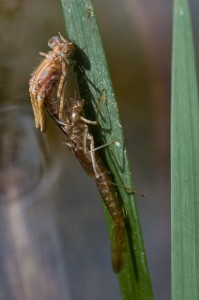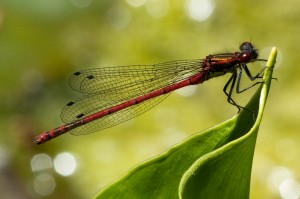At this time of year you may notice lots of damselflies zipping about. As far as I can tell these emerge from the pond earlier than dragonflies, and, who can blame them as they make a tasty meal for their voracious cousins.
The damselfly lays it eggs in or close to water and these hatch after about a month. The nymphs then remain in the pond for one to two years before crawling up a convenient piece of vegetation and emerging from their larval case (exuvia). I think we have had at least 10 emerge from our pond in the last month. Here’s a picture I caught of a damselfy as it was emerging.
 The damselfly then has to sit there as it pumps fluid to its wings and dries out before it can fly off. The time taken for this depends on the weather and one I was watching took about 3 hours in early May, but about half that time a couple of weeks later.
The damselfly then has to sit there as it pumps fluid to its wings and dries out before it can fly off. The time taken for this depends on the weather and one I was watching took about 3 hours in early May, but about half that time a couple of weeks later.
Damselflies are much smaller than dragonflies, and sit with their wings held in to their long slim body (thorax) unlike dragonflies which are much larger and wider and who hold their wider wings out.

This is a large red damselfy (which I think is the species that emerged from the pond in early May). Unfortunately they only tend to live for a few weeks so enjoy them whilst you can. Can you think of a better reason to put a pond in your garden than to see these fantastic creatures close-up?
For a great introduction to dragonflies and damselflies see the Leicestershire and Rutland Dragonfly Group website.